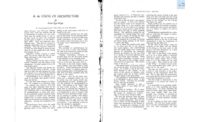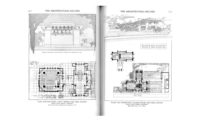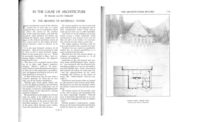The conception of the room within, the interior spaces of the building to be conserved, expressed and made living as architecture – the architecture of the within – that is precisely what we are driving at, all along. And this new quality of thought in architecture, the third dimension, let us say, enters into every move that is made to make it – enters into the use of every material; enters the working of every method we shall use or can use. It will characterize every form that results naturally from this integral interpretation of architecture in its demand upon us for integrity of means to ends – for integrity of the each in all and of the all in all in whatever we do – yes, from pic to proprietor, from a chicken-house to a cathedral.
One more word is indispensable to get the essence of this matter of creation visible on the surface.
That word is PRINCIPLE.
In an earlier paper, there is an attempt to define character and to throw some light on the vexed matter of style!
Principle is the working scheme, or the scheme at work in character, style, integrity, truth or beauty. It is not a motif but a means. We might say principle is the law that governs the production of any one or all of them.
The principle of anything is the law that works its being.
Natural law is principle, or the other way around, as you please. Our application of what we understand of principle is mostly expedient, seldom a genuine working of principle. That is all that is the matter with us. Principle is the tool with which the architect must consciously work to be a safe man or get great effects in his work.
He may be an artists – that is, he may be sentient to his finger-tips and be merely artistic without this command of principle, or, let us say, without this noble submission to its command, never knowing the commend when seen or heard or “sensed.”
In command or principle or commanded by it, only so is the artist potential in creation.
This miserable assumption of virtues though one has them not, may be expedient but it is all the hell there is attached to this affair of getting spirit materialized in works that gratify supremely human desires – we might say, getting the Beautiful born. And then have someone pop up and say with a sneer, “Yes, but what is beauty?” as though beauty were a commodity like soap, cheese or tobacco.
Well, yes. Here, in beauty, is another word to stumble over or mumble with in this age of the pragmatic “expedient” which, after all, is only an experiment.
But, not we have them all in a row – Poetry, Romantic, Ideal, Beauty – faithful mistresses of principle which we may now name Truth. And “Integrity,” “Character,” “Style,” are attributes, merely, of the working of the master – Principle.
Wat is Beauty? And Keats’ “Ode to a Grecian Urn” answers – “Truth, Beauty – Beauty, Truth.”
Obviously, the gifted boy was right, but the nature of either is no nearer for his statement – in the case of the young architect who wants to build something that is both true and lovely. Before we get out of this, that word “love” and the word “joy,” too, will get in, I feel sure. Here they are at this moment. Very well, let them in to the distinguished company they know so well. And then let us ask them for help.
“Art is the evidence of man’s joy in his work,” man has said. And that love is the motivating power in creation we all know by experience.
We are talking about creating or about creations, and this motivation, “Love,” is essential to any conception of it – to any beginning of it.
Conceive, then, in love, and work with principle, and what men call Beauty will be the evidence of your joy in your work. After the purity and intensity of your desire or love, then, according to the degree that you have got command of Principle or willingly obey its commands, that materialization of spirit will appear in your work and earthly form – and men will call it Beauty.
Look about you at earthly forms! Trees, flowers, the reactions to one another of the elements in sky, earth and sea. All are merely effects of the working of definite principles with definite “materials” – which are really only elements in the creative hand.
The “design” of this in the altogether is too large in pattern to be yet comprehended by man, yet for our purposes in all or in each, we may find the evidence we week of method in creation.
Method in creation?
It is there most certainly. Principle is at work continually in this school for architects – working there with simple materials and never-failing ideas of form. The form is a consequence of the principle at work. It would seem that no proper excuse for “making” anything ugly need ever be accepted from an architect – with all this prima facie evidence surrounding him, evident even in his own fingers as he writes or draws. He may study forms, “types” constructed by the infallible working of interior principles in this common school. What escapes us is the original idea or ultimate purpose.
This urge to create the beautiful for love of beautiful is an inheritance. Enough for us that because of the inheritance we have carved out for ourselves with imagination, this higher realm of Beauty.
With imagination, then, let us try to learn the method of working principle with such simple elements as are everywhere put into our hands as materials. Love in our hearts – passion, yes, is essential to success, as our motif.
Now having done our best to light up these words and discuss the relationship existing between them, we will go on to talk of those matters, as hard as nails, as pointed as tacks, as flat as a barn-door, that are involved in the method – of creation.
Love no one can give. Assuming that inspiration is in the heart, we can show facts and performances with materials according to Principle that will be helpful to others in relation to method in creation.







